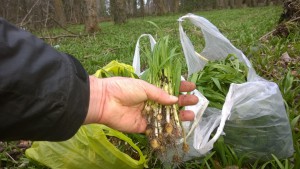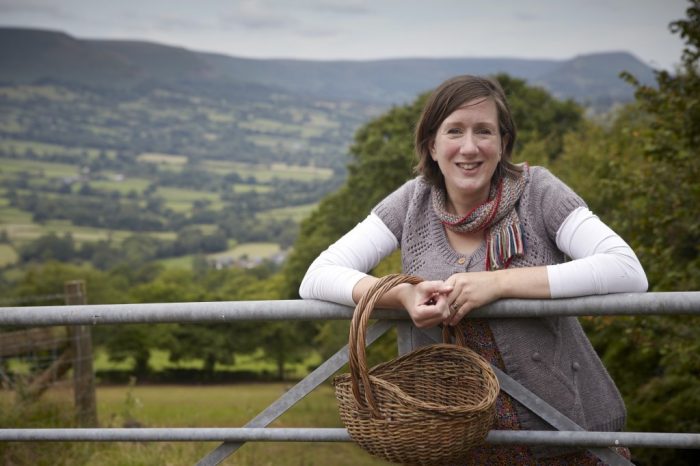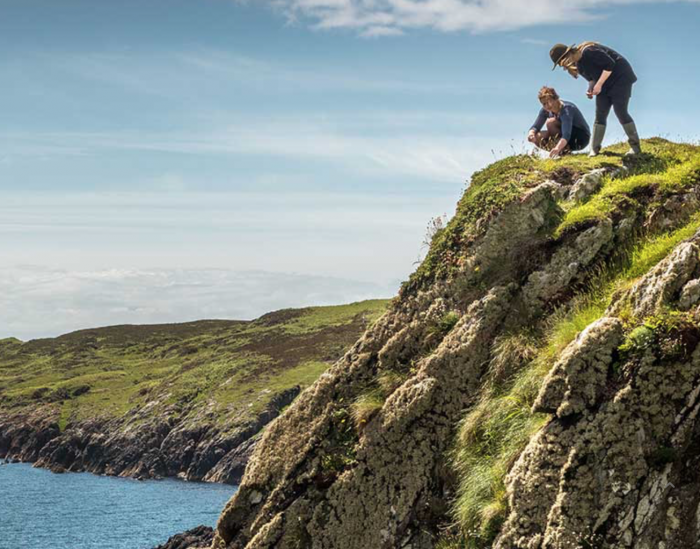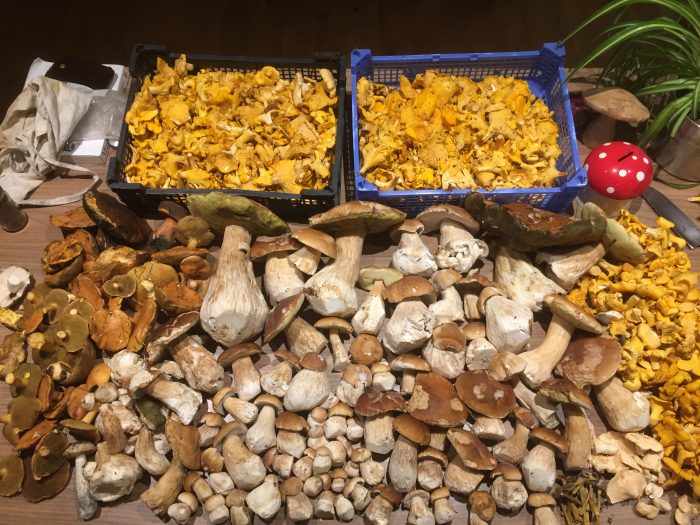Foraging in the Modern World : Foraging For Money
As foraging grows ever more popular some voices question its impact. In this series of articles, foraging teacher Mark Williams explores how it fits into a society set on consuming itself.
Browse more blogs on the politics of foraging
Gathering wild ingredients to sell rather than to consume one’s self gets a lot of stick – even from foragers. I have been on both sides of this divide myself. In my youth I sold chanterelles for beer money. Later I worked as a commercial forager/salesman, before choosing to specialise in teaching rather than harvesting. Poacher-turned-gamekeeper, for a while I disparaged commercial harvesting. Nowadays, while I still think foraging for one’s self and family works best, I now see no reason why considered commercial harvesting should be a problem per se.

A great business opportunity for someone: Harvesting few flowered leek (considered a problematic non-native invasive species by some) from a 6 acre patch
Let’s be clear – hardly anyone in the UK currently makes a full-time income from wild harvesting. Please, please disregard tabloid press pieces about “hoards of Eastern Europeans pillaging our forests” for vast profits. They are sensationalist, never based on evidence, and often racist in tone. If you get your information from this sort of press, and take it in any way seriously, you’d probably be better off listening to Nigel Forage!
I have unpicked this question at length here, but its worth repeating this illuminating example from a friend who forages for pleasure and profit in the New Forest:
“A few years ago when I was out in the forest I was “tipped off” by a couple that there was a gang of East European pickers nearby with walkie talkies. I’ve never seen gangs of pickers before so I went looking. It turned out that the “gang” was in-fact two Polish families out mushroom hunting and the “walkie talkies” were rather old mobile phones. They stopped for a picnic and I had a chat with them. I guess it helped that I’m half Polish but they certainly weren’t picking to sell. We talked mushrooms and I saw that they had about 10 ceps and a dozen assorted boletes between them. Hardly a lot! They were just out enjoying the autumnal sunshine doing what many British people would like to be able to do but don’t have the knowledge“.
Its also worth having a look at this photograph that is churned out every autumn by foraging nay-sayers as “evidence” of outrageous behaviour by commercial fungi foragers. I believe it was originally taken in Epping Forest, but has since appeared in dozens of articles with no connection to that area.
At first glance, and with a limited knowledge of fungi, you could be forgiven for thinking this is an outrageous amount of wild mushrooms to remove from a forest. But here are a few thoughts:
- How would you feel if these were blackberries rather than mushrooms? There is no evidence whatsoever that harvesting fungi has any more impact on mycelia, than picking blackberries has on brambles.
- This photo is usually presented as if it has been confiscated from one picker, or a “gang”. The diversity of the receptacles suggests otherwise, and it is much more likely that these were confiscated over a day, or more, from a number of foragers, harvesting abundant, local food to preserve for their store cupboard.
- Serious commercial harvesters would not be stuffing wet fungi into plastic bags – they would become unsaleable very quickly. (Note: I am not defending the use of plastic bags, that’s a bit gross!)
- Fungi can, and often do, appear in huge surges, where colossal amounts appear in a very short space of time. Boletes (which appear to make up much of what we see in this photo) in particular can have epic localised mass “fruitings” when conditions are correct. Many of the bags also appear to contain honey fungus, which also tends to appear in vast and sudden surges, and are often (incorrectly) villified as a nuisance species – read more about them here). Experienced fungi foragers will tell you that, in some years, this is not an unusually large number of boletes and/or honey fungus to find in a small area in a short period. I certainly don’t find these quantities remotely shocking or excessive. Other fungi, such as chanterelles, winter chanterelles and hedgehog fungi (which don’t seem to appear in this photograph) are slower growing – you can read my deep dive on sustainable harvesting considerations for them here.)
- The sums simply do not add up. To quote from my friend and fellow wild food educator Daniel Butler in this excellent article: “Tesco is currently buying in top quality chanterelles, horn of plenty and hedgehog fungi from Russia for £6 per kg. These retail in the aisles at £20. This is the competition the alleged “gangs” are up against. It would take many hours to gather, say, 100kgs of such mushrooms. These would have to be graded (with up to 50% jettisoned as poor quality); paperwork filled out; then they would have to be transported [to a] wholesaler – who would only buy from a reputable seller with proper insurance. The figures just don’t make any sense.” I would also add that while it may be possible to harvest a commercially viable quantity on specific spots on specific (if unpredictable) days, such harvests come only a few times per year, if at all. There is no reliability or continuity of harvest.
- This photo has been doing the rounds for at least five years, annually recycled by anyone who wants to write a commercial fungi foraging scare story. If commercial harvesting is as rife as these articles suggest, why aren’t there more photos, and why is this one constantly re-purposed?
Sorry to obsess over this photograph, but my intention is to make a wider point: a little knowledge of a subject in the form of scientific research and/or experiential insight is way more valuable than knee-jerk reactions to what looks, or does not look, right to inexperienced eyes.
Here is a comparable photo of what I harvested over two days and many miles in predominantly plantation forestry, using my 30 years of knowledge, experience and connection to the land. I had no interest in selling any of it. This is an important annual harvest for me, which I preserve in many different ways and use to feed family and friends throughout the year. I don’t buy a single commercially grown, hothoused, plastic-packed mushroom all year. If someone stacked up an average families supply of commercially produced button mushrooms for a year and took photo of it, I might find that pretty excessive. But I make no apology for this wild harvest.
I’m not suggesting that nobody forages for financial gain, but the vast majority of money made from wild harvests is through seasonal piecework, or more often people selling surplus from their personal harvests direct to local businesses. This is seldom well paid given the time, knowledge, graft and skill involved. For others, wild harvests are the basis, or more likely a strand, of micro or nano businesses, where value is added to abundant harvests – eg. hedgerow jam, elderberry liqueur, botanical spirits, pop-up dining experiences.
Personally I’d rather give my money to nimble, high quality, rural, local micro-businesses than to supermarkets and agribusiness. Given that all food has consequences, isn’t this a better food choice in the interest of rural economies and minimising our overall impact on the natural world?

Liz Knight of Forage Fine Foods harvest abundant hedgerow plants from the around her home and makes them into delicious preserves to sell
Businesses that forage their own ingredients from the wild often give back way more than they take. A friend of mine was recently sworn and shouted at by a passer-by while picking primrose flowers for making wine. They were so busy being furiously righteous that they couldn’t hear him explaining that he’d recently planted several hundred primroses around the locale. (For some reason many myths circulate around the legality of picking primrose flowers: for the record, they are super-abundant in most areas and there are no prohibitions on picking them, other than than an arcane bye-law in Northern Ireland). There are countless examples of the reconnection and responsibility being exhibited by thoughtful, nimble wild food businesses. Despite using many island botanicals, The Botanist Gin takes the conscious decision not to harvest Islay juniper due to its scarcity, but through The Botanist Foundation is working to reintroduce it around the island.

Nurturing prostrate juniper on Islay, where it is under threat not from foragers, but by extensive, subsidised, sheep grazing.
Commercial foragers are subject to the law of the land, which infers that landowner’s permission should always be given for commercial harvests. Miles Irving – a wild food supplier and well respected author from Kent – is looking to challenge some of those creaky old laws which seek to erode basic human rights through contrived ideas of “ownership”, partial understandings of wild species and intransigent attitudes to new ways of relating to nature.
Relationships between land owners and foragers need not be strained or adversarial, and are more often than not warm and mutually beneficial. Win-win acts of stewardship, such as thinning a riverbank of reedmace, cuttiing japanese knotweed or pulling ground elder are common.
There may come a time when certain wild harvests are so popular that some species come under ecological pressure in some locations. If that happens I expect it will be the nimble diets and attitudes of foragers and foraging businesses that will be suggesting alternative harvesting strategies and campaigning for more green space, long before the cumbersome, grinding wheels of law, consumerism and traditional conservation organisations catch up.
Related Articles:


6 Comments
Here in the U.S., specifically in the pacific northwest, commercial harvest really makes it hard for folks who are trying to maintain a strong presence of wild food in their diets. Commercial pickers really do clean out entire forests. Meanwhile you can go into any grocery store during late summer and autumn and find really expensive chantarelles that always look super beat up and really pretty terrible.
Sorry to hear this Timmy. In the UK we are now working on a Wild Food Accreditation Scheme, which is intended to set benchmarks around responsible harvesting practices among commercial foragers.
Do you need to get wild ingredients tested before using them in a commercial product?
I guess that depends on the ingredient, the producer and the scale…
For example, someone making jam from wild blackberries to sell at the local market probably wouldn’t have the time, money or inclination to pay for expensive testing. A large gin brand about to commit to a recipe probably would do a lot more “due diligence”. This should include impact assessments, risk assessments etc. Worth noting that “wild” ingredients are not necessarily, or legally, “organic”.
Anyone supplying the public would be expected to do HACCP analysis – and this should cover the extra things to think about around wild harvests.
So legally, can I forage mushrooms in scotland and sell for example on Facebook market place or local farmers market?
You would need to have the landowner’s permission if you intend to sell them. And what is legal may not always be the same as what is ethical or sustainable.